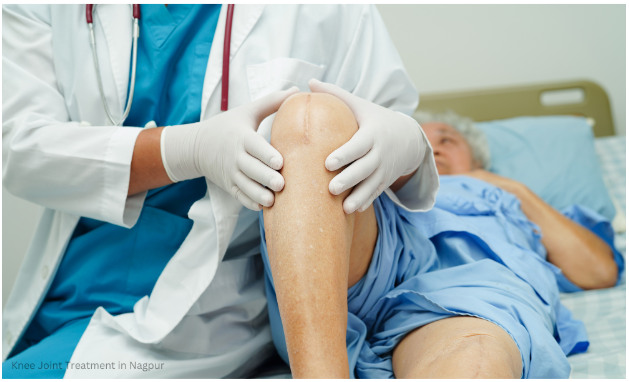Knee Joint Treatment in Nagpur

Understanding the Knee Joint: Anatomy and Function

The knee joint serves as a crucial hinge joint, linking the femur, or thigh bone, to the tibia, known as the shin bone, while being safeguarded by the patella, commonly referred to as the kneecap. Additionally, it comprises menisci, ligaments, and cartilage, which collectively offer cushioning, stability, and flexibility. These elements are essential for supporting weight-bearing activities such as walking, running, and ascending stairs.
Common Causes of Knee Joint Problems
Various elements may lead to damage in the knee joint, resulting in discomfort and limited movement.
- Osteoarthritis: Osteoarthritis is a degenerative joint condition caused by the breakdown of cartilage..
- Rheumatoid Arthritis: An autoimmune disorder that targets the tissues of the joints.
- Sports Injuries: Injuries such as ligament tears (ACL, MCL) and damage to the meniscus.
- Obesity: Increased body weight exerts excessive stress on the knee joints.
- Aging: The inevitable degradation of joint structures over time.
Knee Joint Treatment Options
Non-Surgical Treatments:
- Physical Therapy: Exercises aimed at enhancing the strength and functionality of the knee.
- Medications: Non-steroidal anti-inflammatory drugs to alleviate pain and inflammation.
- Injections: Administration of corticosteroids or hyaluronic acid for short-term relief.
- Lifestyle Modifications: Management of body weight and adjustments to physical activity.
Surgical Treatments:
- Arthroscopy: A minimally invasive surgical procedure aimed at addressing minor injuries.
- Partial Knee Replacement: Surgical intervention involving the replacement of only the affected compartment of the knee.
- Total Knee Replacement (TKR): A comprehensive surgical procedure that entails the replacement of the entire knee joint in cases of severe damage.
Orthopedic Assessment for Knee Joint Treatment
Before recommending a treatment plan, orthopedic specialists conduct comprehensive assessments, including:
- Medical History Assessment: Analyzing the patient’s symptoms and previous treatments.
- Physical Assessment: Evaluating joint mobility, alignment, and stability.
- Imaging Studies: Utilizing X-rays, MRI scans, and CT scans for accurate diagnosis.
- Functional Evaluation: Assessing mobility and restrictions in daily activities.
Post-Treatment Recovery and Care
Effective treatment of the knee joint extends beyond surgical intervention. Essential components of the recovery process encompass:
- Physiotherapy: Crucial for restoring strength and enhancing mobility.
- Follow-Up Appointments: Consistent meetings with your orthopedic specialist.
- Lifestyle Adjustments: Adopting a nutritious diet and engaging in low-impact physical activities